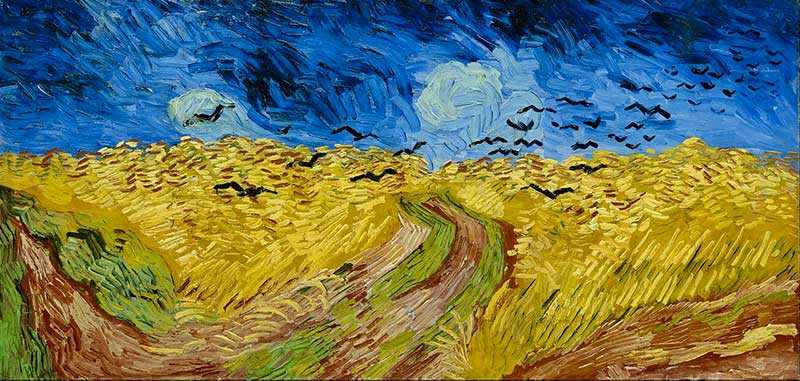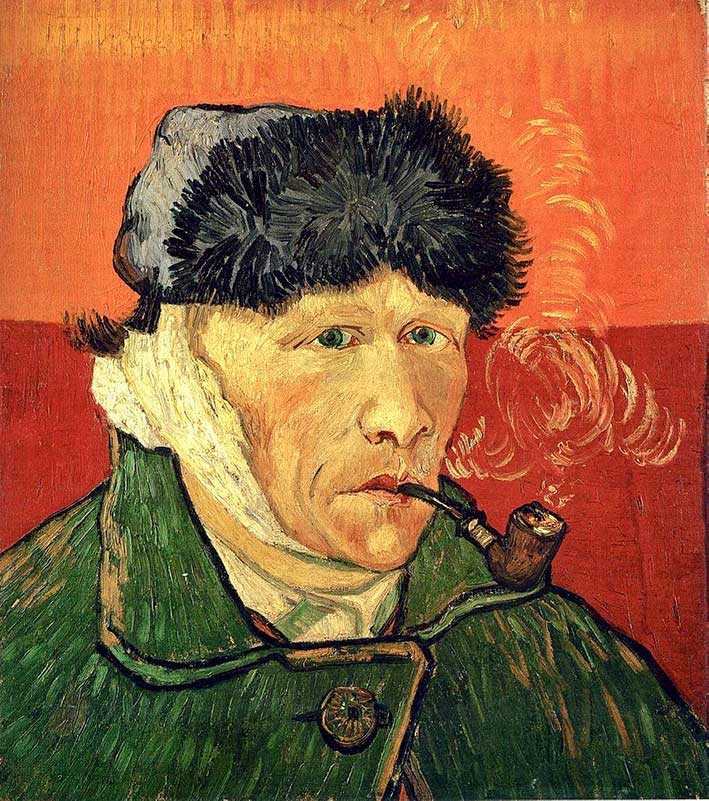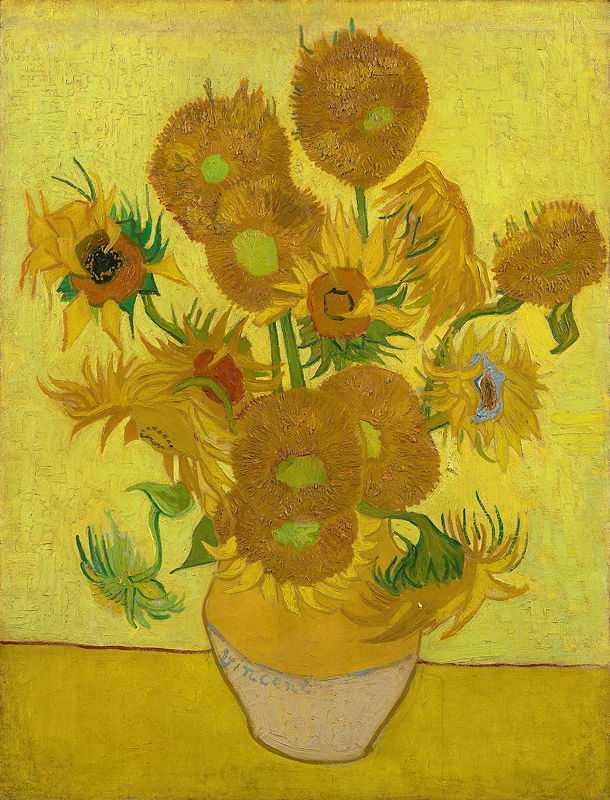1. The Potato Eaters (1885)
The Potato Eaters stands out among Van Gogh’s top 10 paintings.
It was painted in the spring of 1885, before van Gogh's move to Paris, and was intended to act as a showpiece for his figure-painting skills.
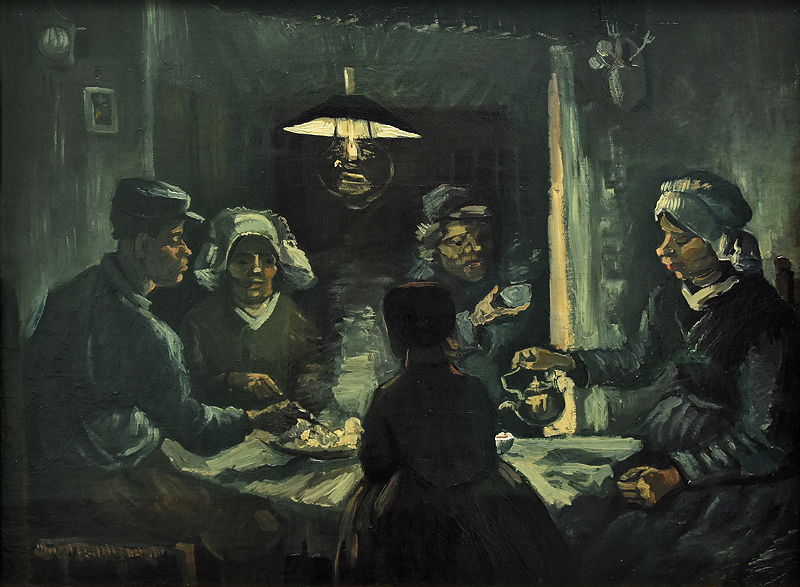
It is by far the most ambitious piece from van Gogh’s Dutch period (which lasted from 1880-1886). It was painted in Neunen in the Netherlands, a small agricultural town where van Gogh was living with his parents, between March and May 1885.
The Potato Eaters was conceived by van Gogh as a painting to show the raw reality of rural life. The hunger and resignation of the peasants really leaps off the canvas. It is the only group portrait that van Gogh ever produced.
In preparation, van Gogh painted over 100 portraits of farmworkers. As he said in a letter to his brother Theo:
"I am plowing on my paintings as they do on their fields."
Palette
The piece is painted with an earthy palette. As van Gogh put it, the palette was:
“something like the colour of a really dusty potato, unpeeled of course”.
The only real colour comes from a single oil lamp above the communal table. This is in stark contrast to the usual impressionist approach and with van Gogh's later works.
The five figures are coarse and plain with almost cartoonish features. The two adults on the left are tucking into a communal dish of steaming potatoes, whilst the two adults on the right are serving and drinking coffee.
The central figure is a young girl, standing at the table (as was the custom at the time). The clock in the top-left of the painting shows that it is indeed dinnertime: 7pm.
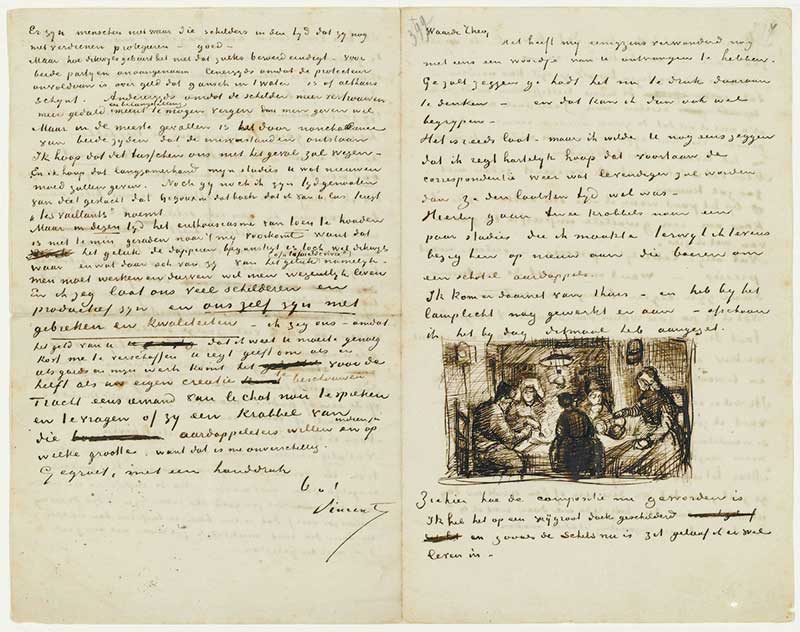
As Van Gogh explained in a letter to his brother Theo:
“I really have wanted to make it so that people get the idea that these folk, who are eating their potatoes by the light of their little lamp, have tilled the earth themselves with these hands they are putting in the dish; and so the painting speaks of manual labor, and how they have honestly earned their food. I wanted to give the impression of quite a different way of living than that of us civilised people. Therefore I am not at all anxious for everyone to like it or to admire it at once.”
Criticism
Van Gogh’s expectations were realised and the piece was met with criticism. In particular, critics shunned the dark colour palette and the poor execution of the figures. Even van Gogh's friend Anthon van Rappard was critical of the work.
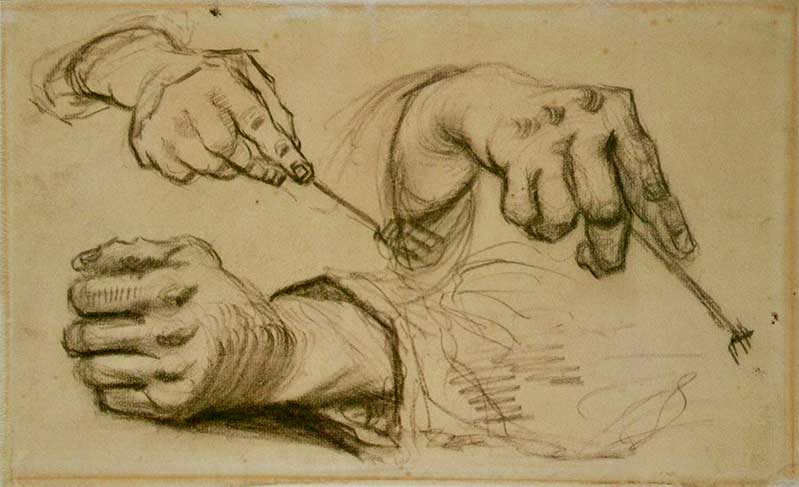
There was something in these complaints: the picture seems to have problems with perspective, and van Gogh (despite making numerous studies of hands) clearly struggled with painting some of the knuckles and fingers.
Where is it now?
The Potato Eaters is now found in Amsterdam's van Gogh museum. It was stolen in 1991 but recovered just 35 minutes after it was reported missing!
An earlier oil study for the work is found in the Kröller-Müller Museum in Otterlo, the Netherlands. That version was also stolen, this time in 1988, but later recovered.
2. Self-Portrait with Straw Hat (1887)
Between the years of 1886 and 1888 Van Gogh lived in Paris.
Here he was exposed to the impressionist movement, as well as the work of the neo-impressionists. During this period, van Gogh painted more than twenty self-portraits.
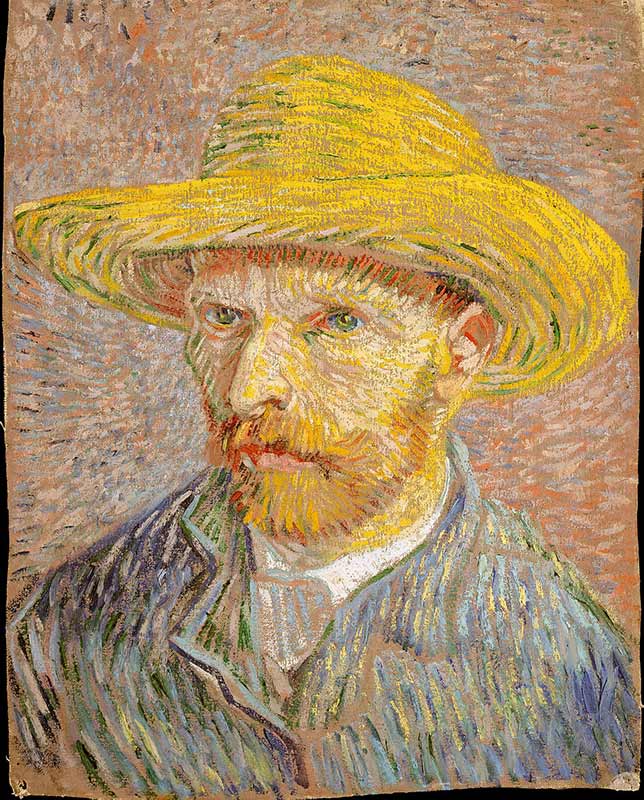
Van Gogh's Self-Portrait with Straw Hat was painted in May 1887, when the artist was 34 years old.
Money worries
This move towards self-portraiture was partly motivated by a lack of money, which meant that van Gogh was unable to pay for a model.
As a result, van Gogh used his own features as material for his figure paintings. In his own words:
"I purposely bought a good enough mirror to work from myself, for want of a model."
In this self-portrait, it is possible to see the influence of the neo-impressionist technique on his work. Van Gogh draws on the same colour theories present in the paintings of Georges Seurat and Paul Signac, building up the painting with numerous brushstrokes in contrasting colours.
However, instead of the dots of paint characteristic of neo-impressionist paintings, van Gogh favoured small flicks and lines.
Two for the Price of One!
This particular piece is painted on the reverse of another painting, a much earlier work featuring a peasant: The Potato Peeler dates from around February to March 1885 and was painted at Nuenen in the Netherlands.

Two years later, van Gogh reused the canvas for this self-portrait. As he explained, the gritty realism of his Dutch period was
"hopelessly out-dated."
Where is it now?
Portrait with Straw Hat is now found at the Met in New York. It is not hung on a wall but is found in a perspex case in the middle of a gallery so that both sides of the canvass can be inspected.
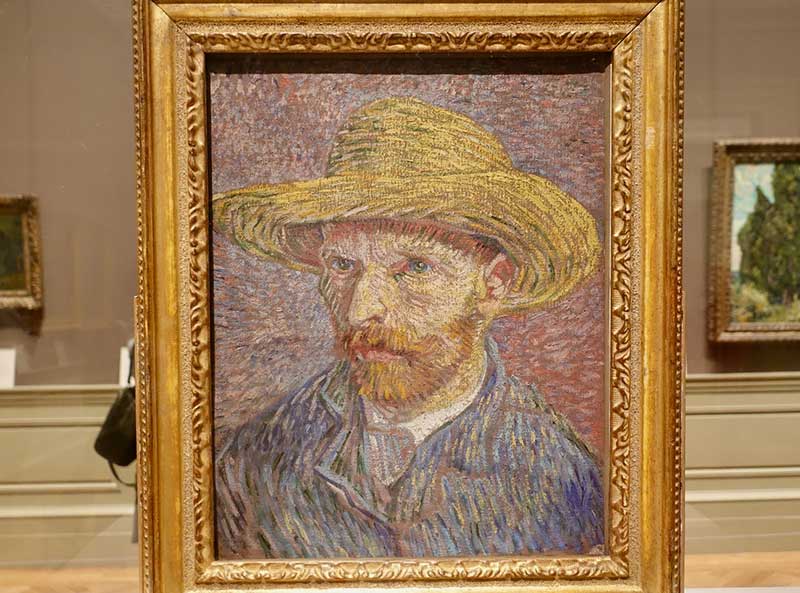
3. Shoes (1888)
Still life paintings of shoes are dotted sporadically through van Gogh’s oeuvre, with most being produced during his time in Paris.
This particular piece was painted later, in 1888, after van Gogh had relocated to Arles to live with Paul Gauguin.
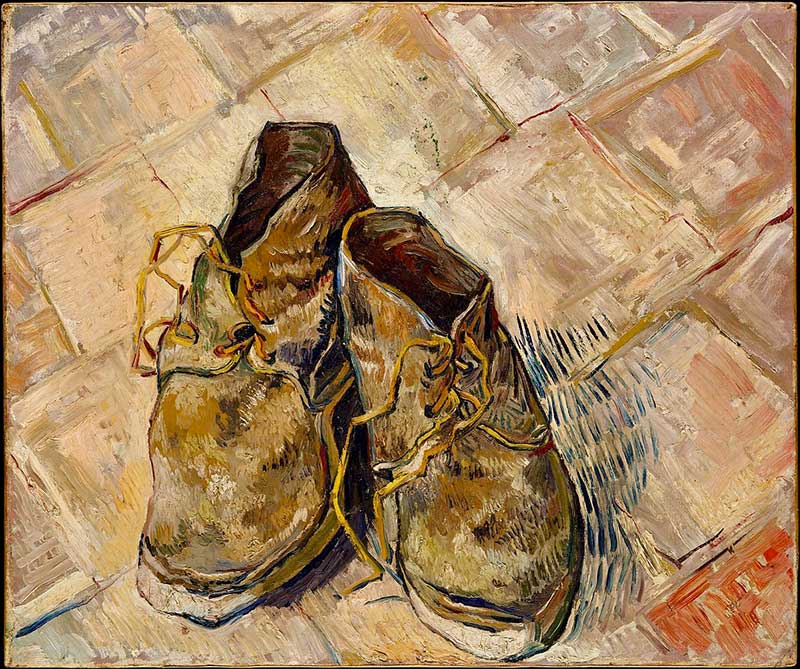
Van Gogh searched for worn out shoes to use for these works. According to one acquaintance, van Gogh would purchase used shoes at flea markets and walk them through the mud to get them even dirtier.
Most of these works were simply titled ‘Shoes’ and often Van Gogh painted over and over on the same canvas.
In this particular piece, we see the shoes of a peasant on a red-tile floor. The floor has been identified as the floor of the Yellow House where van Gogh stayed in Arles in 1888.
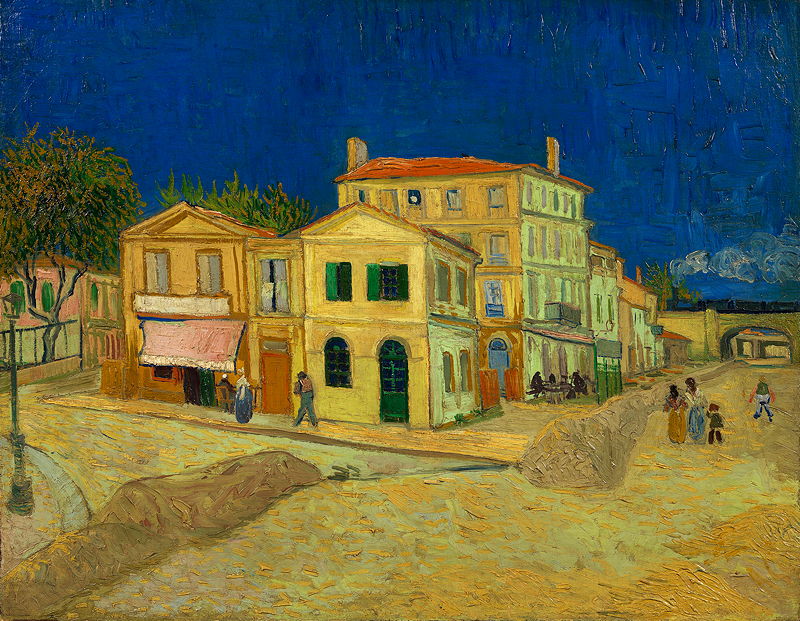
The shoes may have belonged to Patience Escalier, who also sat for a portrait around this time. This is the only pair of shoes van Gogh painted during the Arles period.
A Pair of Clogs
Van Gogh later, in the Autumn of 1889, painted a pair of wood-soled leather clogs.
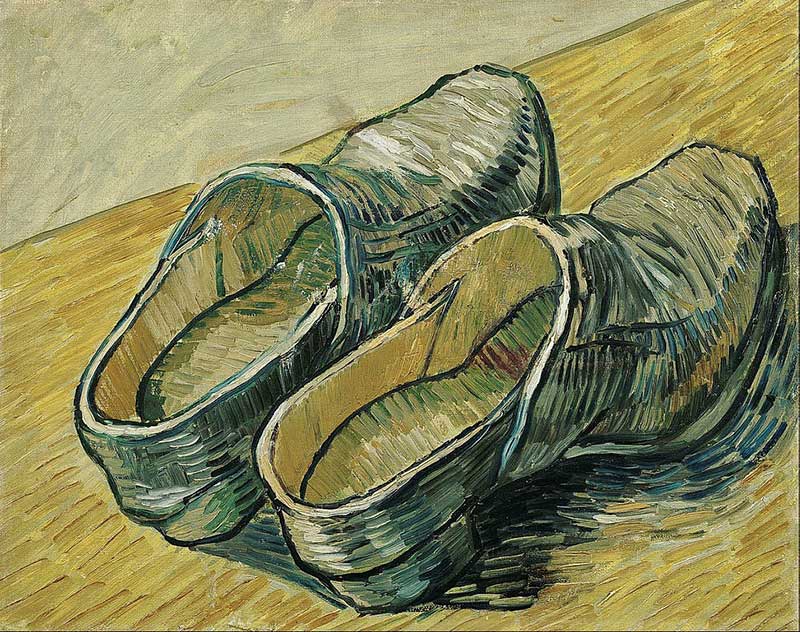
Two points of interest arise here. First, van Gogh painted this work during a period when he was reluctant to go outside. Secondly, note the odd angle of the surface on which the clogs are arranged.
4. Cafe Terrace at Night (Sept 1888)
In ‘Cafe Terrace at Night’, Van Gogh fulfils his aims of painting a nighttime scene featuring artificial light.
Like many members of the impressionist movement, van Gogh was interested in the effects of gaslight on colours and he wished to paint a scene centring the strong contrast between light and dark.
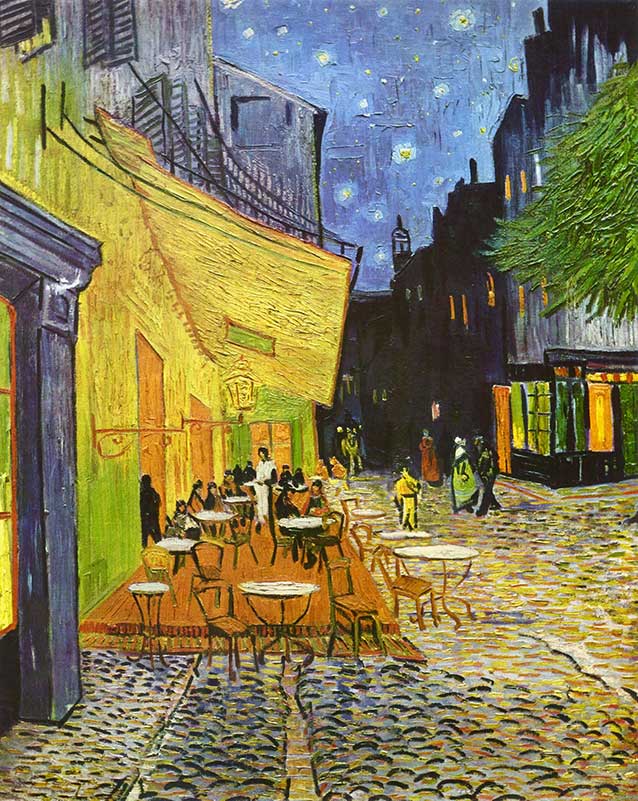
The painting
The eye is immediately drawn to the bright yellow/greens of the cafe scene, with a waiter seemingly taking orders. This contrasts with the blues and violets of the night sky.
The framing of these central elements is made more interesting by glimpse of a shopfront on the bottom-left of the picture and the end of a branch of a pine tree on the right.
van Gogh's comments on the painting
From his writing, it is evident that Van Gogh got great satisfaction from producing this work. In a letter to his sister, he admitted:
"I enormously enjoy painting on the spot at night."
Indeed, he observed the conditions closely, going as far as to paint the exact constellation of the stars as they would have appeared on the 16-17 September 1888.
This painting also gave Van Gogh the opportunity to use his favoured palette of vibrant yellow shades. He described how
“I believe that an abundance of gaslight, which, after all, is yellow and orange, intensifies blue.”
Religion
Spirituality was an important force in van Gogh's life: he was a preacher in Belgium in the late 1870s and he wrote to Theo at about this time explaining that he had a "tremendous need ... for religion".
A closer look at the cafe scene reveals a central figure, surrounded by 12 others and a shadowy character dressed in black walking into the cafe. Could the central figure be Jesus, the 12 customers the apostles, and the shadowy figure Judas?
Where is it now?
This painting is now one of Van Gogh’s most famous. It is found in the Kröller-Müller Museum in the Netherlands. The cafe is still in existence: these days it is called Le Cafe La Nuit.
5. The Night Cafe (Sept 1888)
Depicting the interior of the Café de l’Alcazar in Arles, ‘The Night Cafe’ (Le Café de Nuit) is one of Van Gogh’s most arresting paintings.
The work was partly a study of the effects of artificial light, and part a study about those forgotten by society.
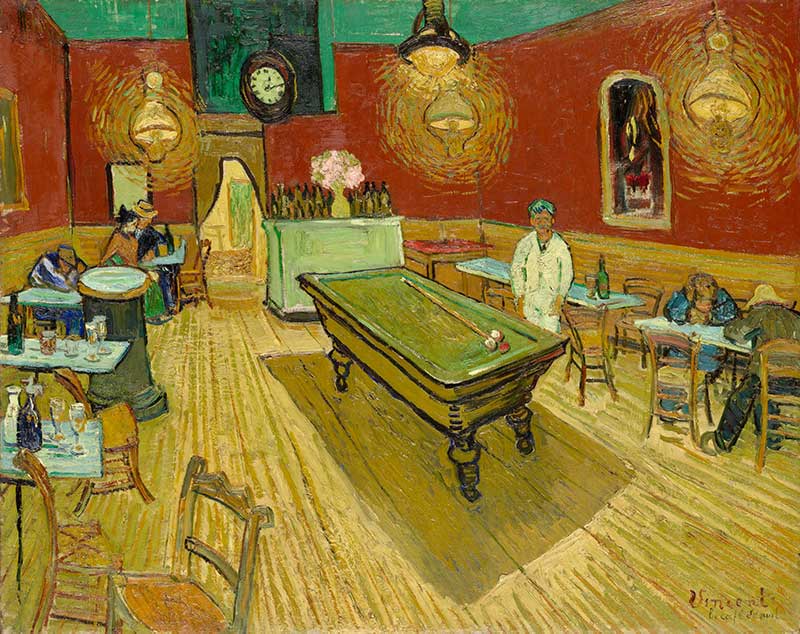
The scene
The scene is dominated by three large electric lights and a snooker table that almost appears to be hovering above the floor. A closer inspection reveals the cafe's proprietor standing behind the snooker table looking at the viewer, smartly dressed in white, and five other drinkers.
Three of them appear to have passed out on the tables in front of them, with the other two (a man and a woman at the back of the scene) sitting close to one another. As the cafe was frequented by prostitutes, it is possible that this depicts a pick-up.
Other details include a central clock showing the time as being a quarter past midnight.
According to Van Gogh, he painted ‘The Night Cafe’ on location, staying up for three nights in a row to finish the canvas. Apparently the landlord was pleased for him to do so.
What van Gogh said
As van Gogh put it, this symbolic piece intended to
“express the idea that the café is a place where one can ruin oneself, run mad or commit a crime. I have tried to express the terrible passions of humanity by means of red and green”, as he wrote to Theo.
The dramatic colour effects can be seen as a culmination of the influences of Impressionism, Post-Impressionism and Japanese wood block prints on Van Gogh’s work.
In his letters, he describes the space in rich detail:
“blood red and dull yellow with a green billiard table in the centre, four lemon yellow lamps with an orange and green glow. Everywhere there is a clash and contrast of the most disparate reds and greens.”
He also wished to capture “the white clothing of the café owner, keeping watch in a corner of this furnace, becomes lemon yellow, pale and luminous green.”
Japanese influences
Within this piece, it is also possible to read other ways that Japanese art influenced Van Gogh’s work, especially his use of a tilted perspective. It is also likely that he drew inspiration from pared-back Japanese interiors when creating the composition.
Having read Pierre Loti’s influential book Madame Chrysanthème, Van Gogh explained to Theo: “Loti’s book Madame Chrysanthème taught me this much: the rooms there are bare, without decorations or ornaments. And that very thing wakened my interest”.
Gaugin's Night Cafe
Paul Gauguin also painted the same room in 1888 but he employed a much cooler palette for his piece.
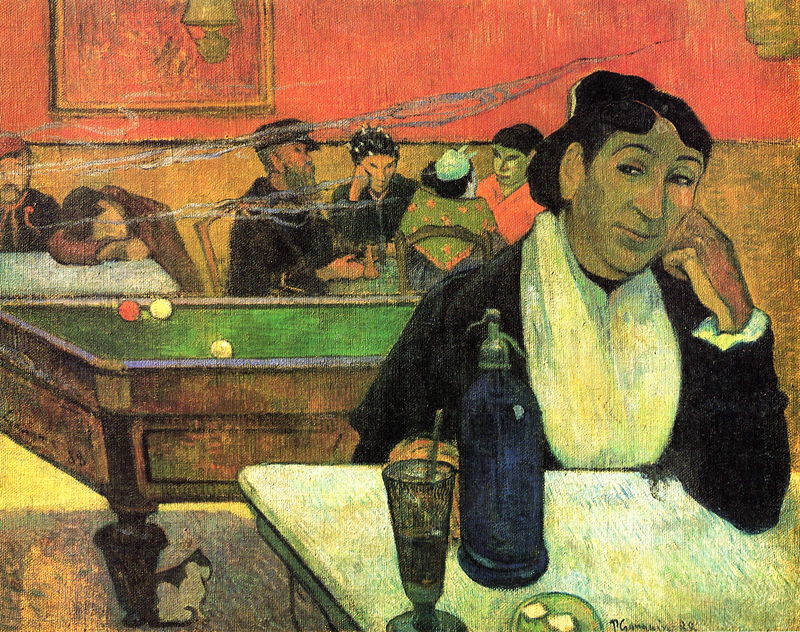
Where is it now?
Van Gogh's Night Cafe is owned by Yale University and is on permanent display at the Yale University Art Gallery.
6. The Bedroom (Oct 1888)
When Van Gogh moved to Arles, it was the first time he had a place of his own.
As soon as he moved in, he began decorating the bedroom and filling the walls with canvasses.
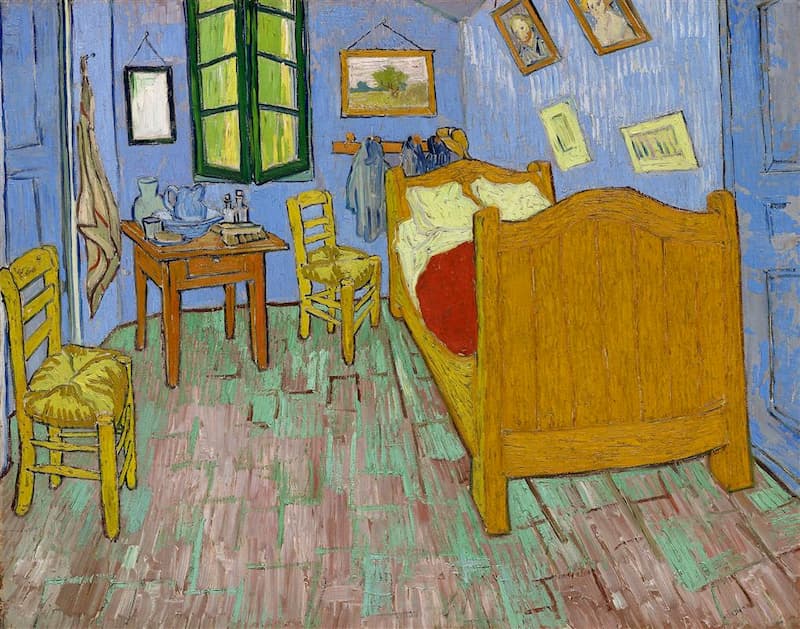
The scene
This is first of three paintings Van Gogh made of his bedroom in the Yellow House in Arles.
It shows a modest bedroom, complete with single bed, bedside table, chair and mirror. The door to the left leads to the guest room where Gaugin stayed; the door to the right to the landing.
A closer inspection shows some interesting details: the pictures above the bed seem to include a van Gogh self-portrait; a sun hat is hanging on a rack at the far end of the bed; and the bedside table seems to display a small glass duck and a birthday cake.
Van Gogh's inspiration
Legend has it that van Gogh got the idea for his painting after spending two and a half days in bed (he was exhausted after cleaning and decorating the Yellow House to make it ready for Gauguin's arrival)!
Isn't it a bit flat?
Van Gogh intentionally sought to flatten the scene, drawing inspiration from the Japanese prints that he collected.
Note also the skewed rear wall (though this was in fact an accurate representation of the bedroom scene).
The three versions
The first two versions are nearly identical. The first, painted in October 1888, was damaged by flood water when van Gogh was an in-patient at Arles' Old Hospital. Van Gogh therefore repeated the work in September 1889. The first and second versions are now found in the van Gogh Museum in Amsterdam and the Art Institute of Chicago respectively.
The third version, also painted in September 1889, was called a 'reduction' by van Gogh. About half the area of the first two, it was painted for van Gogh's mother and sister and is now to be found in the D'Orsay.
Van Gogh's take on the picture ...
Van Gogh was clearly proud of his work, mentioning it in letters to his brother Theo and Gaugin. Both letters included a sketch of the work.
In his letter to Theo he said this:
“It amused me enormously doing this bare interior. With a simplicity à la Seurat. In flat tints, but coarsely brushed in full impasto, the walls pale lilac, the floor in a broken and faded red, the chairs and the bed chrome yellow, the pillows and the sheet very pale lemon green, the bedspread blood-red, the dressing-table orange, the washbasin blue, the window green. I had wished to express utter repose with all these very different tones.”
The next year he said this to Theo: "When I saw my canvases again after my illness, what seemed to me the best was the bedroom."
Originally owned by Theo, the painting then passed to his wife, Johanna van Gogh-Bonger when he died in 1891 and was exhibited at the gallery of Ambroise Vollard in 1895.
The colours
Over time, the colours in the painting have degraded so that they appear far stronger and more contrasting now than when the work was originally produced. Nonetheless, the colour effects combined with the receding perspective would have been dizzying even when the piece was first painted.
7. Starry Night (June 1889)
One of Van Gogh’s most celebrated paintings, and now an iconic work of art, ‘The Starry Night’ was produced in June 1889.
At that time, Van Gogh was in the psychiatric hospital at Saint-Rémy.

He enjoyed observing the night sky, writing “The sight of the stars always makes me dream” and he would have been able to see this view from the window of his room.
The scene
The luminescent moon and eleven stars dominate the canvass. The dark cypress tree gives structure, and the village (with its beautiful church) adds some interesting detail.
While the scene is partly produced from observation, the village is not present in the scene van Gogh was painting: it comes from his memory and imagination.
Van Gogh did not actually rate the painting that highly. He was not to know that it would become one of the most important works of western art. Indeed, he decided not to waste money on the postage required to send it to his brother Theo (an art dealer in Paris) because he didn't think it would sell!
In a later letter to Emile Barnard, van Gogh referred to Starry Night as a
"failure"
Symbolism
The painting is full of vitality, produced from a series of dreamlike swirls and rich colours. For many, it also symbolises an outpouring of Van Gogh’s emotions. The painting can be considered as a meditation on life and death.
Cypresses were often associated with mourning and could commonly be found in graveyards.
As Van Gogh once wrote:
“Why, I say to myself, should the spots of light in the firmament be less accessible to us than the black spots on the map of France? Just as we take the train to go to Tarascon or Rouen, we take death to go to a star.”
Religion?
As with the Cafe Culture, there is an interesting debate about whether Starry Night was inspired by religion. Genesis 37:9 says as follows:
" ... I have dreamed a dream more; and behold the sun and the moon and the eleven stars made obeisance to me."
Starry Night definitely has a moon and eleven stars.
Furthermore, Joseph - who is being quoted in Genesis - also predicted that one day his family would come to respect him. That bears a parallel with van Gogh's life: with the exception of his brother, Theo, his family regarded him as a bit of a loser.
Don McLean
You know a picture is famous when Don McLean writes a song about it. The song is actually called 'Vincent', though it is often referred to as 'Starry Starry Night'.
McLean wrote it on a paper bag, after reading a van Gogh biography, because he wanted to argue that van Gogh was ill and not crazy. It is no doubt for this reason that the lyrics include:
Now, I understand what you tried to say to me /
And how you suffered for your sanity /
And how you tried to set them free /
They would not listen, they did not know how /
Perhaps they'll listen now
Starry Night over the Rhone
Starry Night is a bolder depiction of the night sky than van Gogh's earlier (September 1888) work Starry Night over the Rhone.

Where are they now?
Starry Night is the jewel in the crown of the Museum of Modern Art (MoMA) in New York. Its less famous predecessor, Starry Night over the Rhone, is in the Musee d'Orsay in Paris.
8. Wheatfield with Cypresses (July 1889)
In 1889, Van Gogh admitted himself into the Saint-Paul de Mausole psychiatric hospital at St-Rémy in the south of France.
While he was there, he painted a large number of works depicting views from around the hospital. ‘A Wheatfield, with Cypresses’ is one of several paintings featuring the same subject.
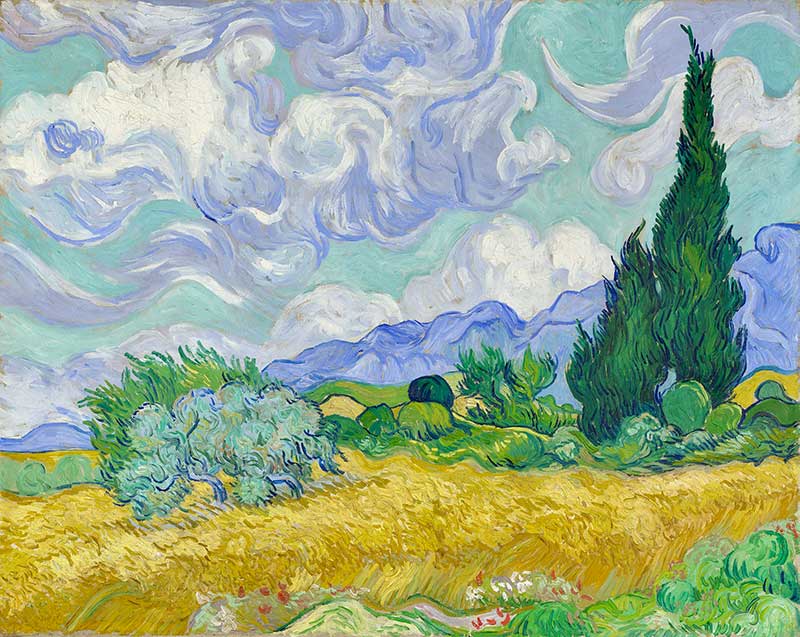
Writing to his brother, Theo Van Gogh, the artist described:
“The cypresses still preoccupy me, I’d like to do something with them like the canvases of the sunflowers because it astonishes me that no one has yet done them as I see them. It’s beautiful as regards lines and proportions like an Egyptian obelisk. And the green has such a distinguished quality. It’s the dark patch in a sun-drenched landscape.”
In this painting, Van Gogh’s aims were realised. The deep green of the cypresses stands out against the pale, swirling blue tones of the sky and the saturated yellows of the wheat field. This work can be seen as an example of Van Gogh’s embrace of
“the artist's liberty to exaggerate, to create […] a world more beautiful, more simple, more consoling than ours”.
These motifs are typical of Provençal art, especially with the absence of any human presence in the scene. In his swirling brushstrokes, Van Gogh gives a sense of the dynamic energy of nature. The lines also echo the Art Nouveau style which was growing in popularity in France during this period.
At the same time, this painting may have held symbolic importance for Van Gogh. As he wrote to his sister in July:
“What else can one do […] but gaze upon the wheatfields. Their story is ours, for we who live on bread, are we not ourselves wheat to a considerable extent, at least ought we not to submit to growing, powerless to move, like a plant, relative to what our imagination sometimes desires”.
Where are they now?
There are three versions of Wheatfields in all: the one above held by London's National Gallery; a similar version (painted in July 1889, two months previously) held by the Met in New York; and a smaller study (held in a private collection).
9. Sunflowers (1888-89)
Van Gogh is perhaps best known for his sunflower still life paintings.
In total he painted five canvasses of sunflowers standing in vases between 1888 and 1889, using just three shades of yellow.

Gauguin described the sunflower paintings as “completely Vincent”.
The paintings
Van Gogh's five Sunflowers are now dispersed around the world, being found in London, Philadelphia, Amsterdam, Tokyo and Munich. Here is a collage of the five paintings:

Though the Sunflowers each use different colours they are based on only two designs. The first three paintings in our collage use the same 15-sunflower design, as do the second two (12 sunflowers).
The paintings share a number of other similarities:
- As noted, each uses three shades of yellow.
- Each painting shows sunflowers at different stages of their lifecycle: freshly cut, starting to wilt, and dried seed heads.
- Each painting has a two-tone pottery vase and and flat background colours.
- Four of the Sunflowers bear Vincent's signature in the upper half of the vase (the Tokyo version is the exception).
Japonisme
While the Sunflowers are now almost synonymous with the artist, these paintings also demonstrate the influence of Japanese art on Van Gogh’s work. He was fascinated by Japanese prints and he and Theo owned hundreds of them.
Before he left for Arles in 1888, Van Gogh admitted to his brother:
“In a way all my work is founded on Japanese art”.
After moving to the South of France, it is possible to see an evolution in Van Gogh’s mind in which he begins to see Arles as the embodiment of Japan in Europe.
Writing to his sister, Wilhelmina, he says:
“Theo wrote me that he had given you Japanese pictures […] For my part, I don’t need Japanese pictures here, for I am always telling myself that here I am in Japan. Which means that I have only to open my eyes and paint what is right in front of me”.
In the case of his still life paintings, Van Gogh borrowed from the minimalism characteristic of the Japanese aesthetic, with the vases of sunflowers surrounded by emptiness. As he described to his brother:
“Their work is as simple as breathing, and they do a figure in a few sure strokes as if it were as easy as doing up your raincoat.”
The symbolism of the flowers also echoes Japanese traditions. Like the sakura blossoms, Van Gogh’s sunflowers give the impression of being impermanent and short lived.
This is emphasised in his earlier work ‘Four Cut Sunflowers’ (1887) depicting broken stems and the drying heads of the flowers.
10. Irises (May 1890)
The evening before van Gogh checked himself out of the Saint-Rémy psychiatric hospital, where he stayed for 374 days from 8 May 1889 to 16 May 1890, he painted four still life works of flowers.
The bouquets reflect the season when they were painted and they are much softer than the artist’s earlier still life paintings, featuring a gentle, harmonious colour scheme.
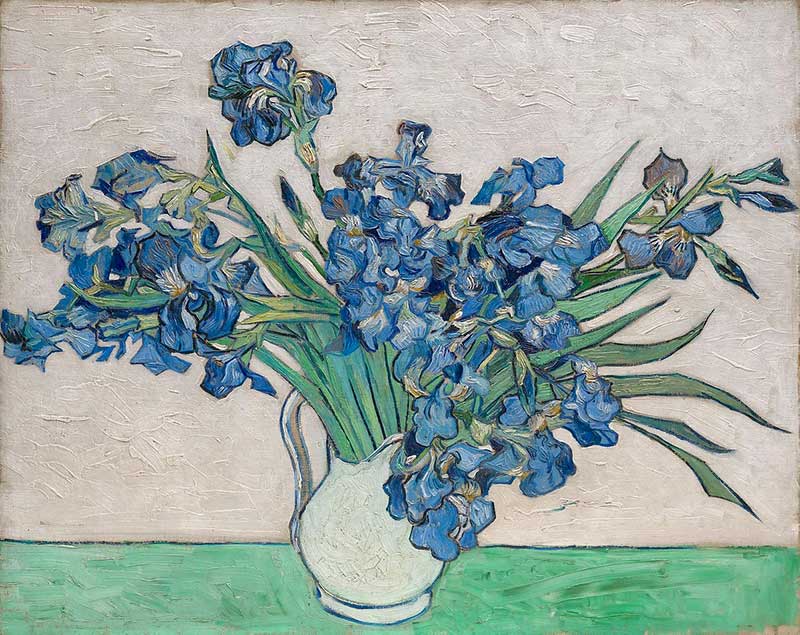
This particular ‘Iris’ piece features an upright arrangement of tumbling iris blossoms, contrasted by pointed fronds of greenery. The violet of the flowers is set against an empty pale pink background and mint green flat surface.
It was first shown in an exhibition in September of the same year, possibly in the apartment of Theo Van Gogh on the Cité Pigalle or at the shop of Julien-François Tanguy at 14, rue Clauzel in Paris.
A set of four
The works were intended by Van Gogh to be displayed as a series, featuring two paintings of roses and two of irises.
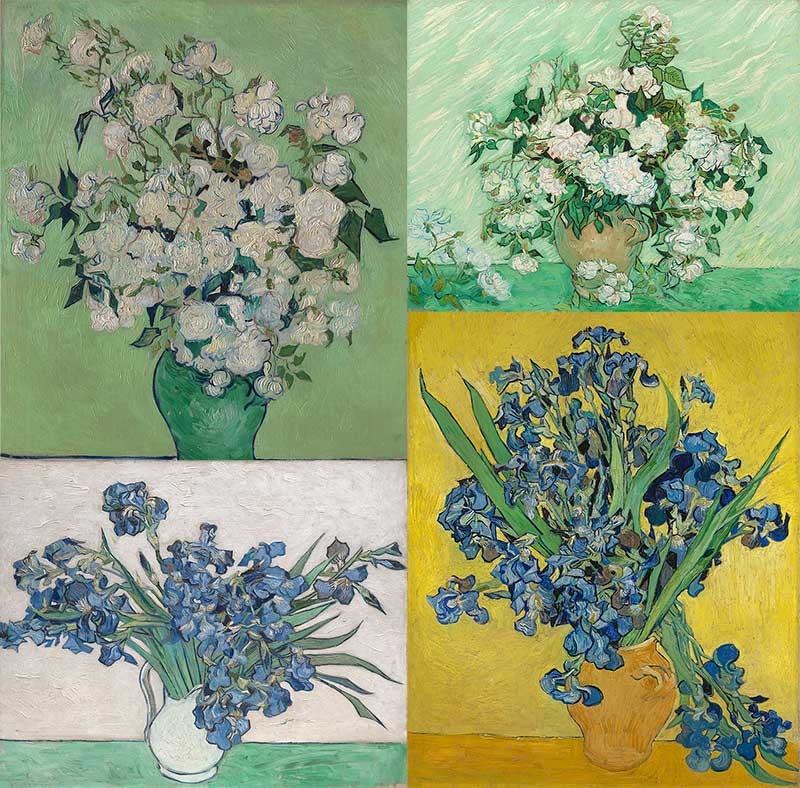
They were reunited in at the Met in New York in 2015, the first time this had happened since van Gogh's death.
What happened to the paintings?
At least two of the pieces were kept by Van Gogh’s mother, Anna van Gogh-Carbentus until 1907 when she died. In a letter from August 1902 she expressed her wish for the Irises to be given to Willemien van Gogh, Vincent’s sister.
Willemien was institutionalised for life at the end of 1902 and the paintings were instead given to Theo and later sold by Johanna van Gogh-Bonger, Anna’s daughter-in-law in March 1908.
Where are they now?
The Met in New York holds one of the Irises and one of the Roses. The other Iris is held by Amsterdam's van Gogh Museum, and the other Rose by the National Gallery of Art, Washington DC.

